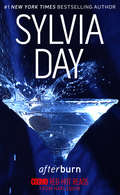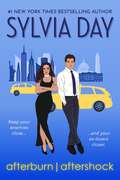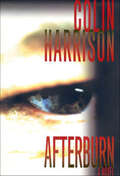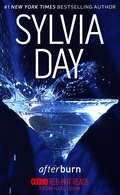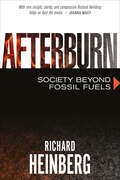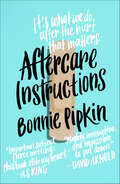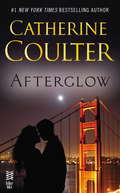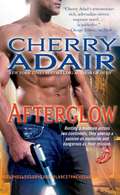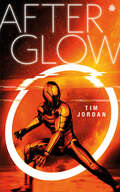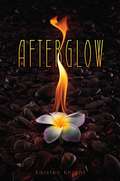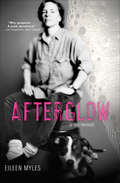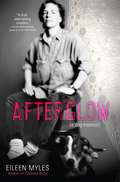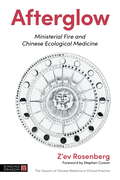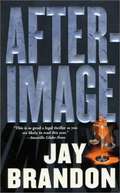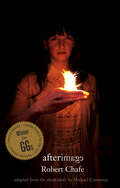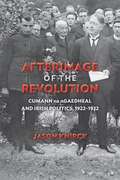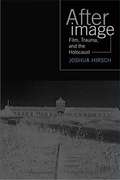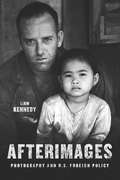- Table View
- List View
Afterburn
by S. L. ViehlAfter driving a mutual enemy across the border territories, the Allied League of Worlds gathers for a peace summit on K-2, the homeworld of the underwater dwelling 'Zangians. With the Bio Rescue team assigned to protect the delegates, Sub-Lieutenant Burn mu Znora's attention is placed on Liana, the daughter of one of the ambassadors, who possesses information vital to the fate of four worlds.
Afterburn
by Sylvia Day#1 New York Times bestselling author Sylvia Day, America's premier author of provocative fiction, delivers the debut novel from Cosmo Red-Hot Reads from Harlequin.The realization that Jax still affected me so strongly was a jagged pill to swallow. He'd only been part of my life for five short weeks two years ago. But now he was back. Walking into a deal I'd worked hard to close. And God, he was magnificent. His eyes were a brown so dark they were nearly black. Thickly lashed, they were relentless in their intensity. Had I really thought they were soft and warm? There was nothing soft about Jackson Rutledge. He was a hard and jaded man, cut from a ruthless cloth.In that moment I understood how badly I wanted to unravel the mystery of Jax. Bad enough that I didn't mind how much it was going to cost me....Look for 2 new eBooks from Cosmo Red-Hot Reads from Harlequin every month.
Afterburn & Aftershock
by Sylvia DayAvailable as a digital anthology for the first time from Cosmo Red-Hot Reads from Harlequin, enjoy Afterburn and Aftershock from America's premier author of provocative fiction, #1 New York Times Bestselling author Sylvia Day. A sizzling miniseries about unexpected reunions, bittersweet revenge, and the fight for redemption.AfterburnThe realization that Jax still affected me so strongly was a jagged pill to swallow. He'd only been part of my life for five short weeks two years ago. But now he was back. Walking into a deal I'd worked hard to close. And God, he was magnificent. His eyes were a brown so dark they were nearly black. Thickly lashed, they were relentless in their intensity. Had I really thought they were soft and warm? There was nothing soft about Jackson Rutledge. He was a hard and jaded man, cut from a ruthless cloth.In that moment I understood how badly I wanted to unravel the mystery of Jax. Bad enough that I didn't mind how much it was going to cost me...AftershockWhen it came to playing games, my lover Jax was a master strategist. He pulled strings behind the closed doors of D.C.'s most powerful political players, and somehow still found time to nearly sideline my career. What he didn't know was that when I didn't like the rules, I threw them out and made my own. I wasn't going to let Jax get away with it. I wasn't going to let him get away at all.I loved Jax enough that it was impossible to give up. Jax loved me enough that giving up was the only end he'd consider. He didn't think I could swim with the sharks. It was entirely my pleasure to show him that I'd already dived in...
Afterburn & Aftershock: Cosmo Red-hot Reads From Harlequin (Afterburn & Aftershock #1)
by Syliva DayAvailable as a digital anthology from Cosmopolitan Red-Hot Reads from Harlequin, enjoy Afterburn and Aftershock from America’s premier author of provocative fiction, #1 New York Times Bestselling author Sylvia Day. A sizzling miniseries about unexpected reunions, bittersweet revenge, and the fight for redemption.Now an original movie from PassionFlix. AfterburnThe realization that Jax still affected me so strongly was a jagged pill to swallow. He’d only been part of my life for five short weeks two years ago. But now he was back. Walking into a deal I’d worked hard to close. And God, he was magnificent. His eyes were a brown so dark they were nearly black. Thickly lashed, they were relentless in their intensity. Had I really thought they were soft and warm? There was nothing soft about Jackson Rutledge. He was a hard and jaded man, cut from a ruthless cloth.In that moment I understood how badly I wanted to unravel the mystery of Jax. Bad enough that I didn’t mind how much it was going to cost me....AftershockWhen it came to playing games, my lover Jax was a master strategist. He pulled strings behind the closed doors of D.C.’s most powerful political players, and somehow still found time to nearly sideline my career. What he didn’t know was that when I didn’t like the rules, I threw them out and made my own. I wasn’t going to let Jax get away with it. I wasn’t going to let him get away at all. I loved Jax enough that it was impossible to give up. Jax loved me enough that giving up was the only end he’d consider. He didn’t think I could swim with the sharks. It was entirely my pleasure to show him that I’d already dived in....Visit the author at SylviaDay.com, facebook.com/authorsylviaday and twitter.com/sylday.
Afterburn / Aftershock: Cosmo Red-hot Reads From Harlequin (Mills And Boon Cosmo Red-hot Reads Ser.)
by Sylvia DayNever mix business with pleasure. Never bring politics into the bedroom. In a way I did both when I took Jackson Rutledge as a lover. I can’t say I wasn’t warned. Two years later, he was back. Walking into a deal I’d worked hard to close. Under the tutelage of Lei Yeung, one of the sharpest businesswomen in New York, I had picked up a thing or two since Jax walked away. I wasn’t the girl he once knew, but he hadn’t changed. Unlike the last time we’d drifted into each other’s lives, I knew exactly what I was dealing with… and how addictive his touch could be. The inner circle of glamour, sex, and privilege was Jax’s playground–but this time, I knew the rules of the game. In the cutthroat business world, one adage rules all: keep your enemies close and your ex-lovers closer…
Afterburn: A Novel
by Colin HarrisonA high-voltage international thriller about a millionaire businessman catapulted into a world of criminal intrigue, sexual obsession, extortion, and death.Charlie Ravich is a survivor whose brutal experience as a POW in Vietnam has more than prepared him for the cutthroat world of global commerce. Now a wealthy Upper East Side executive in his late fifties, Charlie has only one problem: his family is dying out. His wife teeters on the edge of Alzheimer's; their son has succumbed to leukemia; and their daughter, Julia, is unable to bear a child. Charlie is being trumped by time.Enter Christina, a beguiling Columbia University dropout-intelligent, selectively dishonest, filled with desire. Her affair with Rick Bocca, a member of a big-time truck-theft ring run by mobster Tony V., has landed her in prison. After four years in Bedford Hills, she is suddenly released by the Manhattan D.A.'s office-perhaps because she is innocent, perhaps not.Warned by a detective that Christina is being set up by Tony V., Rick begins a desperate, bungled search to warn Christina, who has lied her way into the high-flying world of Charlie Ravich. But her past catches up with her, and Rick's catches up with him, setting off a harrowing chain of betrayals that leaves only one person with any hope of a future.At once smart, sexy, and graphically violent, Afterburn spans the mean streets of New York's underworld and Hong Kong's corridors of high finance, and stands as Colin Harrison's most commercial work yet
Afterburn: Cosmo Red-hot Reads From Harlequin (Afterburn & Aftershock #1)
by Syliva Day#1 New York Times bestselling author Sylvia Day, America’s premier author of provocative fiction, delivers a story with unexpected reunions, bittersweet revenge, and the fight for redemption.The realization that Jax still affected me so strongly was a jagged pill to swallow. He’d only been part of my life for five short weeks two years ago. But now he was back. Walking into a deal I’d worked hard to close. And God, he was magnificent. His eyes were a brown so dark they were nearly black. Thickly lashed, they were relentless in their intensity. Had I really thought they were soft and warm? There was nothing soft about Jackson Rutledge. He was a hard and jaded man, cut from a ruthless cloth.In that moment, I understood how badly I wanted to unravel the mystery of Jax. Bad enough that I didn’t mind how much it was going to cost me…Originally published in 2013
Afterburn: Society Beyond Fossil Fuels
by Richard HeinbergEssential, visionary essays about our post-carbon future Climate change, along with the depletion of oil, coal, and gas dictate that we will inevitably move away from our profound societal reliance on fossil fuels; but just how big a transformation will this be? While many policy-makers assume that renewable energy sources will provide an easy "plug-and-play" solution, author Richard Heinberg suggests instead that we are in for a wild ride; a "civilization reboot" on a scale similar to the agricultural and industrial revolutions.Afterburn consists of 15 essays exploring various aspects of the 21st century migration away from fossil fuels including:Short-term political and economic factors that impede broad-scale, organized efforts to adaptThe origin of longer-term trends (such as consumerism), that have created a way of life that seems "normal" to most Americans, but is actually unprecedented, highly fragile, and unsustainablePotential opportunities and sources of conflict that are likely to emerge.From the inevitability and desirability of more locally organized economies, to the urgent need to preserve our recent cultural achievements and the futility of pursuing economic growth above all, Afterburn offers cutting-edge perspectives and insights that challenge conventional thinking about our present, our future, and the choices in our hands.AWARDSFINALIST | 2015 Foreword INDIES: Essays
Aftercare Instructions: A Novel
by Bonnie PipkinEveryone is talking about Aftercare Instructions, Bonnie Pipkin’s electric debut novel:“Important, fierce. Pipkin stole my heart with this book.” —A.S. King, author of Still Life with Tornado“Mighty, innovative, and nearly impossible to put down.” —David Arnold, author of Kids of Appetite“Incredibly honest and empathetic.” —ALA Booklist“Big-hearted, sensitive, and engrossing.” —Publishers Weekly“Troubled.” That’s seventeen-year-old Genesis according to her small New Jersey town. She finds refuge and stability in her relationship with her boyfriend, Peter—until he abandons her at a Planned Parenthood clinic during their appointment to terminate an unwanted pregnancy. The betrayal causes Gen to question everything.As Gen pushes herself forward to find her new identity without Peter, she must also confront her most painful memories. Through the lens of an ongoing four act play within the novel, the fantasy of their undying love unravels line by line, scene by scene. Digging deeper into her past while exploring the underground theater world of New York City, she rediscovers a long forgotten dream. But it’s when Gen lets go of her history, the one she thinks she knows, that she’s finally able to embrace the complicated, chaotic true story of her life, and take center stage.Aftercare Instructions, a debut full of heart and hope, follows Gen on a big-hearted journey from dorm rooms to diners to underground theaters—and ultimately, right into readers' hearts.
Afterglow
by Catherine Coulter#1 New York Times bestselling author Catherine Coulter delivers a novel of an author finding her own real-life hero... <P> As a writer, Chelsea Lattimer is an expert at putting romantic heroes on paper. They're masterful, gentle, gorgeous, and great lovers. What they are not is David Winter, a serious, stuffed-shirt doctor with a blue-blood pedigree. <P> Chelsea can't blame her friends for trying to fix her up. And though she admits that there's an undeniable chemistry between her and David, that's as far as it's going to go--until David decides to transform himself into one of the heroes in Chelsea's novels... <P> Includes a preview of The Aristocrat.
Afterglow
by Cherry AdairNew York Times bestselling author Cherry Adair delivers the next book in her latest paranormal romance series following Hush. New York Times bestselling author Cherry Adair is back with the next book in her latest paranormal romance series featuring the men and women of Lodestone. They can retrieve anything, anyone, anywhere....
Afterglow
by Irene B. BrandAs a freelance writer, Hester's six-month assignment is to record the one-hundred-year history of a picturesque Appalachian town called Afterglow nestled in a deep valley. But in so doing, some of the town's questionable past comes roaring to the surface, shaking the very foundation of the little hamlet. As a daughter, suffering the recent loss of her mother, she is drawn to Afterglow to resolve the questions raised by the words in a long-lost letter delivered to Hester but addressed to her mother. As a single, unattached woman, Hester sees her journey as a welcome change, perhaps just what she needs to begin a new life. But on her way to Afterglow, Hester feels like she's being followed . . . or could this mysterious man be a link to her future?
Afterglow
by Tim JordanTim Jordan returns with the hotly-anticipated sequel to his mind-bending 2021 debut, GlowGlow is not gone. Glow remains. Glow is alive. The nanotech drug is now everywhere. It creeps across the world, a mind-bending plague, a brain-altering poison that lives on from host to host, twisting everyone to its will.Still recovering from his addiction, Rex remains in hiding, battling the voices in his head that are not all his own. Some days are peaceful, others are downright terrifying. But there are bigger problems to face – a new alliance threatens the balance of power in the world again, and a dangerous enemy from Rex's past tracks him down.Can Rex really be the cure for the plague that Sisters promised him, or the root of humanity&’s downfall? Faced with ultimate destruction, Rex must decide if he really is a prophet... or just a coward.File Under: Science Fiction [ Welcome to my Half-Life | I'm Glowing Down | Feeling Ruff | Tech Blues ]
Afterglow (Wildefire)
by Karsten KnightThe action thrills and the passion burns in this red-hot conclusion to the Wildefire trilogy which “offers potent magic and plenty of action” (Booklist).Teenage volcano goddess Ashline Wilde discovers that her former love, Colt Halliday, has an evil plan to kill the Cloak, the benevolent beings that oversee the gods. And that’s not all—he also wants to merge Ash and her two sisters back into a single, too-powerful goddess, Pele. Ash must stop her trickster-god ex-boyfriend once and for all…and to do it, she’s going to have to feed a few flames.
Afterglow: (a dog memoir) (Books That Changed the World)
by Eileen Myles“A ravishingly strange and gorgeous book about a dog that’s really about life and everything there is…astonishing.” ?Helen Macdonald, New York Times-bestselling author of H Is for HawkIn 1990, poet Eileen Myles chose Rosie from a litter of pit bulls on the street, and their connection instantly became central to the writer's life and work. During the course of their sixteen years together, Myles was madly devoted to the dog’s well-being, especially in her final days. Starting from the emptiness following Rosie's death, Afterglow launches a heartfelt and fabulist investigation into the true nature of the bond between pet and pet owner. Through this lens, we witness Myles’s experiences with intimacy and spirituality, celebrity and politics, alcoholism and recovery, fathers and family history, as well as the fantastical myths we spin to get to the heart of grief.Moving from an imaginary talk show where Rosie is interviewed by Myles’s childhood puppet to a critical reenactment of the night Rosie mated with another pit bull, from lyrical transcriptions of their walks to Rosie’s enlightened narration from the afterlife, Afterglow illuminates all that it can mean when we dedicate our existence to a dog.“Myles gets at something no other dog book I’ve read has gotten at quite this distinctly: The sense of wordless connection and spiritual expansion you feel when you love and are loved by a creature who’s not human…raw and affecting.” ?Maureen Corrigan, Fresh Air, NPR
Afterglow: A Dog Memoir
by Eileen Myles<P>This newest book paints a kaleidoscopic portrait of a beloved confidant: the pit bull called Rosie. <P>In 1990, Myles chose Rosie from a litter on the street, and their connection instantly became central to the writer’s life and work. During the course of their sixteen years together, Myles was madly devoted to the dog’s wellbeing, especially in her final days. Starting from the emptiness following Rosie’s death, Afterglow (a dog memoir) launches a heartfelt and fabulist investigation into the true nature of the bond between pet and pet-owner. Through this lens, we witness Myles’s experiences with intimacy and spirituality, celebrity and politics, alcoholism and recovery, fathers and family history, as well as the fantastical myths we spin to get to the heart of grief. <P>Moving from an imaginary talk show where Rosie is interviewed by Myles’s childhood puppet to a critical reenactment of the night Rosie mated with another pit bull, from lyrical transcriptions of their walks to Rosie’s enlightened narration from the afterlife, Afterglow (a dog memoir) illuminates all that it can mean when we dedicate our existence to a dog.
Afterglow: Ministerial Fire and Chinese Ecological Medicine
by Z'ev RosenbergInspired by personal observations of the climate crisis, as well as health issues from patients involving ministerial fire, this text dives into the concepts of ming men and ministerial fire - core concepts of Chinese medical diagnosis and treatment. This book will assist practitioners in understanding the mechanisms of treating patients with autoimmune diseases, allergies, skin disorders and arthritic disorders.With material from the classic texts, Z'ev Rosenberg explains the concepts ming men and ministerial fire and its relation to the clinical treatment of chronic disorders and its ecological and philosophical implications for life on this planet.Including case histories, acupuncture strategies and herbal formulas, Afterglow is for practitioners that want to deepen their Chinese medicine knowledge in order to treat these complex yet common disorders.
Afterimage
by Helen HumphreysIN THE TURBULENT WORLD OF VICTORIAN ENGLAND, A MAID, MISTRESS, AND MASTER ARE DRAWN INTO A FATEFUL LOVE TRIANGLE.
Afterimage
by Jay BrandonDistrict Attorney Chris Sinclair has never really forgotten his first real love, Jean, a college girlfriend from the era of free love, a wild young woman who introduced him to a world of sex and drugs and alcohol drastically unlike his own. But she left his life in college and he's never seen her since, until a young woman is found buried in a shallow grave on the outskirts of San Antonio. Through forensic reconstruction of the decomposed skull, a face takes shape. A detail or two is different, but there's no doubt the face is Jean's, like an after image in his mind, he sees her face in the young girl's and he knows. What he doesn't know is why Jean wouldn't have reported her own daughter's disappearance; the body had been buried for months.
Afterimage
by Kevin J. Anderson Kristine Kathryn RuschThe strange people had restored her life after she had been raped and burned nearly to death. The only model they had to work with was her assailant.
Afterimage
by Michael Crummey Robert ChafeSeeing beyond Winston’s disfiguring scars and foreseeing a future with him, Lise falls in love and the couple soon marry. Years later, having inherited Lise’s gift, two of their children, Theresa and Jerome, must struggle to find their place within the community. But for Leo, their middle child, that is just the start of his worries. As he grows older and the chasm between himself and his family grows, Leo realizes that he doesn’t belong to his family. While familial tensions mount and secrets are revealed, the Evans family come to see the monumental effect even the smallest spark can create. Based on the short story by Michael Crummey, Afterimage explores the connections built within both family and community, of finding a place to belong. Winner of the 2010 Governor General's Literary Award in Drama
Afterimage of the Revolution
by Jason KnirckAscending to power after the Anglo-Irish Treaty and a violent revolution against the United Kingdom, the political party Cumann na nGaedheal governed during the first ten years of the Irish Free State (1922-32). Taking over from the fallen Michael Collins and Arthur Griffith, Cumann na nGaedheal leaders such as W. T. Cosgrave and Kevin O'Higgins won a bloody civil war, created the institutions of the new Free State, and attempted to project abroad the independence of a new Ireland. In response to the view that Cumann na nGaedheal was actually a reactionary counterrevolutionary party, "Afterimage of the Revolution" contends that, in building the new Irish state, the government framed and promoted its policies in terms of ideas inherited from the revolution. In particular, Cumann na nGaedheal emphasized Irish sovereignty, the "Irishness" of the new state, and a strong sense of anticolonialism, all key components of the Sinn Fein party platform during the revolution. Jason Knirck argues that the 1920s must be understood as part of a continuing Irish revolution that led to an eventual independent republic. Drawing on state documents, newspapers, and private papers--including the recently released papers of Kevin O'Higgins--he offers a fresh view of Irish politics in the 1920s and integrates this period more closely with the Irish Revolution.
Afterimage: Film, Trauma, and the Holocaust
by Joshua HirschThe appearance of Alain Resnais' 1955 French documentaryNight and Fogheralded the beginning of a new form of cinema, one that used the narrative techniques of modernism to provoke a new historical consciousness. Afterimagepresents a theory of posttraumatic film based on the encounter between cinema and the Holocaust. Locating its origin in the vivid shock of wartime footage,Afterimagefocuses on a group of crucial documentary and fiction films that were pivotal to the spread of this cinematic form across different nations and genres. Joshua Hirsch explores the changes in documentary brought about by cinema verite, culminating in Shoah. He then turns to the appearance of a fictional posttraumatic cinema, tracing its development through the vivid flashbacks in Resnais'Hiroshima, mon amourto the portrayal of pain and memory inThe Pawnbroker. He excavates a posttraumatic autobiography in three early films by the Hungarian IstvÁn SzabÓ. Finally, Hirsch examines the effects of postmodernism on posttraumatic cinema, looking atSchindler's Listand a work about a different form of historical trauma,History and Memory, a videotape dealing with the internment of Japanese Americans during the Second World War. Sweeping in its scope,Afterimagepresents a new way of thinking about film and history, trauma and its representation. Author note: Joshua Hirschis visiting lecturer in Film and Electronic Arts at the California State University, Long Beach.
Afterimages
by Arlene CroceDancing leaves nothing else behind--no record, no text--and so the afterimage becomes the subject of dance criticism. A dance critic tries to train the memory as well as the organs of sense; he tries to make the afterimage that appears in his writing match the performance. 10 years of reviews of dancing, from ballet to Balanchine to Twyla Tharp.
Afterimages
by Liam KennedyIn 2005, photographer Chris Hondros captured a striking image of a young Iraqi girl in the aftermath of the killing of her parents by American soldiers. The shot stunned the world and has since become iconic--comparable to the infamous photo by Nick Ut of a Vietnamese girl running from a napalm attack. Both images serve as microcosms for their respective conflicts. Afterimages looks at the work of war photographers like Hondros and Ut to understand how photojournalism interacts with the American worldview. Liam Kennedy here maps the evolving relations between the American way of war and photographic coverage of it. Organized in its first section around key US military actions over the last fifty years, the book then moves on to examine how photographers engaged with these conflicts on wider ethical and political grounds, and finally on to the genre of photojournalism itself. Illustrated throughout with examples of the photographs being considered, Afterimages argues that photographs are important means for critical reflection on war, violence, and human rights. It goes on to analyze the high ethical, sociopolitical, and legalistic value we place on the still image's ability to bear witness and stimulate action.

